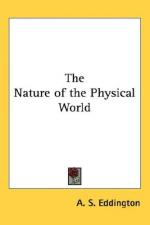|
This section contains 383 words (approx. 2 pages at 300 words per page) |
World of Scientific Discovery on Arthur Stanley Eddington
Arthur Stanley Eddington was born in Kendal, Westmoreland, England, on December 28, 1882. He was the son of a school headmaster and distinguished himself at a very early age with his grasp of mathematics. He was appointed professor of astronomy at Cambridge University in 1913 and became director of the Cambridge observatory one year later.
Eddington's theoretical investigations into the structure of stars helped solve a question that had been plaguing scientists: if the Sun was only a giant ball of gas, what kept it from collapsing under its own gravity to become a white dwarf star? In the 1920s, Eddington proposed that the stellar matter at the core of the star was under extreme pressure, causing the production of tremendous heat. The temperature would reach millions of degrees, and the outward pressure of this radiation would balance the inward pull of gravity. This high temperature would be crucial to establishing the nuclear process as worked out later by Hans Bethe.
Eddington's theory about the interior of stars also disproved a hypothesis regarding the formation of the solar system. Some scientists held that the solar system had been formed when another star passed by the Sun and the star's gravitational tug pulled material from the core of the Sun that coalesced into the planets. Eddington, however, postulated that any material pulled from a star's core would expand violently into a thin gas once released from the pressure that contained it.
In 1924 Eddington proposed his mass-luminosity law: a more massive star would have greater interior pressure, higher temperature, and be more luminous. A star with fifty times the mass of the Sun would be blown apart by the force of its radiation. Another theory Eddington formulated concerns Cepheid variable star s; they pulsate regularly, changing both their size and brightness, because they are at the edge of stability.
In addition to his theories about stars, Eddington was one of the first to understand the importance of Albert Einstein 's theories of relativity.
Eddington was an extraordinarily gifted writer. For the student of physics, he wrote texts that made the notorious difficulties of the subject clear and intuitive. He also wrote numerous books which introduced these difficult concepts to the public, becoming one of the early astronomy "popularizers." He was knighted in 1938 and died on November 22, 1944.
|
This section contains 383 words (approx. 2 pages at 300 words per page) |


